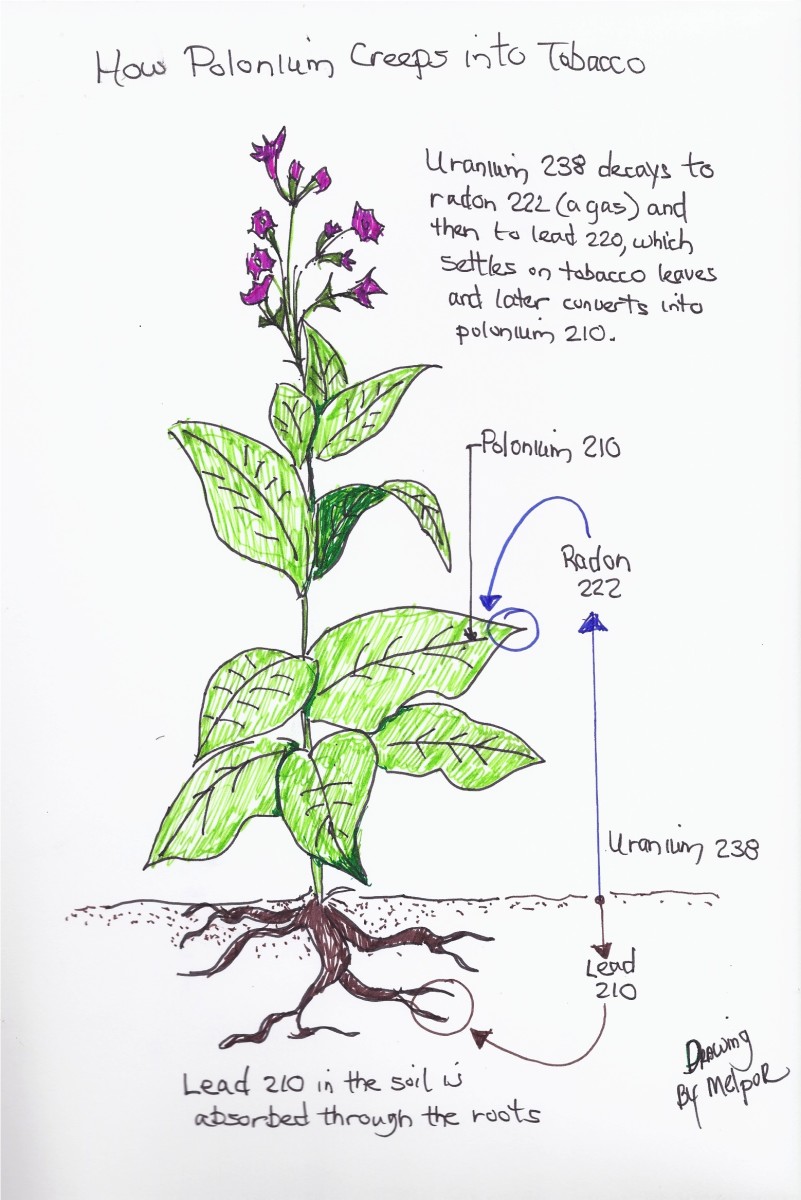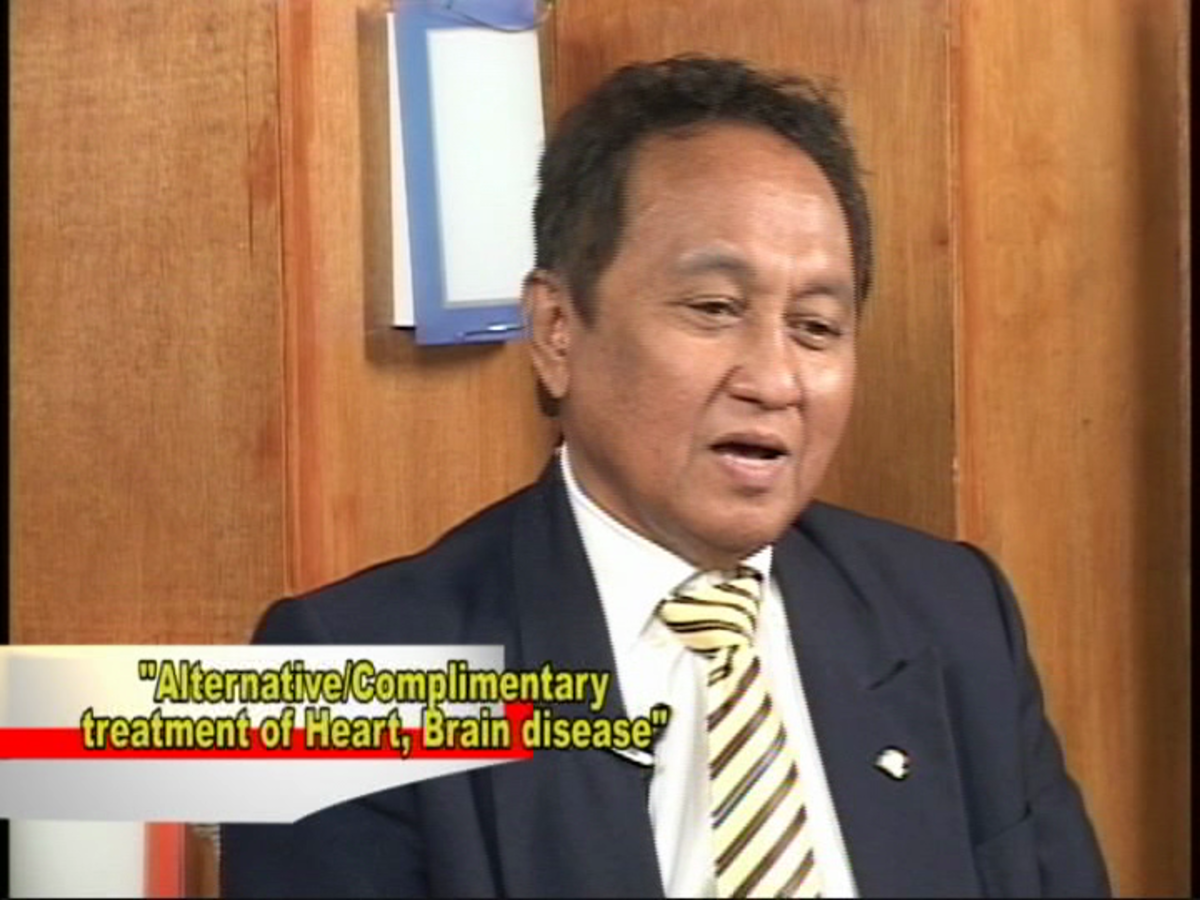Free Radicals and Radiation in Smoke Cause Cancer and Heart Disease
Tobacco accumulates polonium 210 and lead 210; jatropha (below) accumulates copper, the soil (yellowish) used in this experiment is a copper mine tailing

Amaranthus is an accumulator of zinc

Tobacco accumulates polonium 210 and lead 210 that produce free radicals and X-rays
Tobacco accumulates radioactive materials
Tobacco absorbs and accumulates polonium 210 and lead 210, radioactive materials in its leaves. It may need them or may not but the fact is, these semi-metals are found in tobacco leaves, and smoke.
Some plants are accumulators of metals others are not. For example, cashew stores selenium in its nuts. Amaranthus (uray) accumulates zinc (Prasad, M. Heavy Metals in Plants.1999). A species of fern (Pteris vittata L.) accumulates arsenic from the ground. The eucalyptus tree accumulates gold. An accumulator absorbs and stores a mineral in its tissues in amounts more than it needs. Sometimes a plant may just absorb and adsorb a mineral even when it does not need it.
Jatropha (Jatropha curcas), a medium height tree, accumulates copper. It needs only 20 parts per million (ppm). It accumulated 356 ppm in 6.5 months from germination in an experiment done at the University of the Philippines Los Baños in 2009. Seedlings grew vigorously on mine copper tailings used as growing medium (see picture of one seedling above).
Lead 210 is concentrated on the leaves. Polonium 210 is concentrated by the tobacco plant (Microsoft Encarta 2009). In other words, the tobacco plant is an accumulator of lead 210 and polonium 210.
Tobacco gets polonium 210 from the fertilizers (phosphates) applied to raise it (Cranton, E., MD. and A. Brecher. Bypassing Bypass. updated edition. 1984:160).
Radiation, mutation, cancer
A radioactive material is unstable. To attain stability it goes through decay called tunnelling. The radioactive polonium 210 emits alpha particles and alpha radiation, a form of energy, through a barrier, the nucleus. Alpha particles tunnel through the nucleus. Radiation hits tissues like the DNA, the heredity material. DNA has a lot of hydrogen that consists of one proton and one electron. The hydrogen bond (like in water) joins the bases of DNA together but the joints are weak. Hydrogen has no nucleus so it is all the easier for radiation to hit its elements. In fact, the strength of the bond between hydrogen electron and proton is only 5% that of the ionic bond (of salt) or covalent bond (like iron) according to Tortora and associate (Tortora G. and J. Becker. Life Science. 1978:14).
In the hydrogen bond, there is a potential energy barrier. In both sides of this barrier are potential wells. One is shallower than the other. The proton normally settles on the shallower well. However, it can tunnel to the shallower well when hit by radiation. When replication of DNA occurs while the proton is at the shallower well, the pairing between bases of DNA is compromised (lenntech.com. Aug. 26,2014)
That is, an error in copying of the original pairing occurs. This error results in mutation in DNA that can result further in tumor or cancer.
“The bases of DNA are the parts that hold the key to inheritance. The four bases are adenine (A), thymine (T), guanine (G), and cytosine (C). In the two strands of DNA, A is always complementary to (pairs with) T, and G is always complementary to C...During mitosis, the chromosomes are replicated by the unwinding and pulling apart (splitting) of the DNA strands, a new strand is formed alongside the old. The old strand serves as a template so that wherever an A occurs on the old strand, a T will be directly opposite it on the new, and wherever a C occurs on the old strand, a G will be placed on the new. Complementary bases pair with each other until two entire double-stranded molecules are formed where originally there was one” (Taylor T. E. and T. G. Field. Scientific Farm Animal Production. 1998:219-220, parenthetical supplied)
Tumor or cancer starts in one mitotic cell. That is, a cell that produces two daughter cells by a process called mitosis. There are four stages of mitosis. At the start is a rest period where a cell has 46 chromosomes. Next, each chromosome duplicates itself. Next, the duplicates unwind and pull apart. Then two sets of chromosomes come together resulting in two daughter cells, each containing 46 chromosomes. The hydrogen bond in the chromosomes are vulnerable to radiation during the splitting of duplicates. Copying error occurs.
Polonium 210, with 84 protons, decays and stabilizes at polonium 206, with 82 protons. A proton is paired with an electron. There is a loss of two protons during alpha decay leaving two unpaired electrons. These unpaired electrons make for free radicals that are unstable. To stabilize itself, a free radical grabs one or two electrons from a neighboring molecule like DNA. This grabbing results in mutation of DNA, that, in turn, results in tumor or cancer.
So radiation and free radicals from the decay of polonium 210 may result in mutation of DNA that may result in tumor or cancer.
The supply of polonium 210, with a half life of 138.4 days, lasts for a long time. How? Polonium 210 originated from lead 210 with a half life of 22.5 years. Both polonium and lead are deposited in tobacco leaves. Given that the risks of mutation from one batch of polonium lasts for 138.5 years. However, lead supplies batches of polonium continuously for at least 22.5 years.
“Po-210 is the alpha emitting granddaughter of Pb-210, and can be used to represent the actual Pb-210 concentration in each sample because the two isotopes are assumed to be in seqular equilibrium” (lenntech.com). That sample can be tobacco, or cigar smoke, or cigarette smoke.
If you stopped smoking now you had already ingested lead 210 that will supply polonium 210 for at least 22.5 years more.
"The daughter, or decayed, nucleus will have two fewer protons and two fewer neutrons than the original .... Once the electrons have rearranged themselves (and the two excess electrons have wandered off), the atom will, in fact, have changed identity" (Encyclopedia Britannica 2009).
But the partners (electrons) of the formerly 84 protons are not reduced in number. So, there are still 84 electrons after the annihilation of two protons. There are two extra electrons that are free, "wandering off," and are looking for partners. These two, unpaired extra electrons make polonium 210 a free radical.
Polonium has a half life of 138.4 days. That is, if a person had inhaled polonium 210 by smoking, or from stream smoke, polonium will stay in his body that long. That is a long, long time. Compare that with the life span of hydroxyl radical, a derivative of oxygen, that is only 0.000000001 seconds (Sharma, H., MD. Freedom from Disease. 1997). In that short span of life, a molecule of hydrogen peroxide can do damage, called peroxidation, by grabbing electrons. The two free electrons in polonium may not take that long to find another electron belonging to another molecule or tissue and grab.
Lead 210
It is found in the same ore where uranium is found. One product of uranium decay is radon-222 which escapes from the ground and goes to the atmosphere. Radon-222 decays to lead-210 that falls to the ground (Encyclopedia Britannica 2009).
From the soil, the tobacco plant accumulates lead 210 in its leaves (Microsoft Encarta 2009).
Double whammy of radiation and free radicals
Decaying polonium 210 emits energy in the form of radiation, among others. Polonium 210 gives off radiation in at least 138.4 days; lead 210 lasts for at least 22 years. That means that a person who smokes everyday will accumulate an unknown amount of radiation from day 1 to 22 years until he dies of natural death. But most likely he will die due to heart disease, or cancer much earlier. There are over 200 kinds of cancer.
If polonium 210 and lead 210 were the only sources, polonium 210 will supply a smoker with radiation and free radicals until his death at 100 years old (assuming a natural death) even when he had stopped smoking at the age of 78. Indeed, 44 years after the death of a smoker lead 210 will be found in his bones and DNA still emitting radiation. The amount of tar, believed to be the carcinogenic material, a cigarette stick contains is known.
[DNA can last thousands of years. The DNA of the pharaohs can be used to identify them. I have a Hub "How Criminals Can Neither Fool Nor Escape From DNA Fingerprinting"]
However, it is certain that a lot of people die of heart disease, the number one killer in the world; and of cancer, the number two killer in the world. This was the state of affairs around tobacco in 1975 yet (Epstein, S. S. MD. The Politics of Cancer. 1978).
Heart disease
If orphaned electrons from the decay of polonium 210 grab electrons from one cell of the inside wall of an artery of the heart, or if radiation mutates the chromosomes in one cell, the injury results in a benign tumor called atheroma. The body tries to repair this injury with collagen, fibrin, elastin, cholesterol and calcium. But the repair goes awry. The patch grows thick and becomes a mound, then an occlusion, then a plaque. The plaque narrows the artery that lessens the flow of blood. Lessened blood flow starves the heart for oxygen resulting in angina pectoris or chest pain. Lack of oxygen causes death of heart muscles. Death of several heart muscles that makes the heart unable to pump results in heart attack (Cranton, E., MD. and A. Brecher. Updated edition. 1984).
New entries as of October 12,2011
Framework of analysis
So far, I have not come across an analysis of cigarette or tobacco using the framework of free radical theories of disease. The item radiation may belong in both free radical theories and conventional medicine as this recognizes that radiation causes disease if given in overdose.
The analysis of cigarette smoke has gone as far as risk factor with one common warning that a cigarette stick shortens a person’s life by one second through smoking or stream smoke.
A risk factor, in the framework of conventional medicine, is not considered as a cause. It belongs in the logic of association not in the logic of causation.
A risk factor is a device used to predict the probability that a person will contract a disease (DeBakey, M. MD and A. Gotto, MD. The New Living Heart. 1997).
The alternative framework of free radical theories of disease recognizes that free radicals cause disease. This framework was formulated by Dr. Denham Harman, MD in 1962 when he made an interpretation that free radicals cause disease and aging. It is considered as a breakthrough in medicine in the same class as the germ theory of disease inaugurated by Louis Pasteur in 1881-1884.
In Congressional hearings in the United States over carcinogens in the 1970s, tobacco was analyzed by tar content, carbon monoxide, nicotine, flavor, additive, and other constituents like benzene, hydrazine, vinyl chloride, etc. (Epstein, S. MD. The Politics of Cancer. 1978:150-177). In all 583 pages of Epstein’s book there is no entry of the term “free radical.” However, there are several entries of “X-ray.” [I have a Hub "Opening the Book on Tobacco: Recasting a Case Study in 'The Politics of Cancer' Under a New Framework"].
Completely absent in Epstein’s book are the terms “polonium 210” and “lead 210.” Fortunately, I found these entries in the book of Dr. Elmer Cranton, MD and A. Brecher (Bypassing Bypass) in the first printing, updated version (1984) and second edition.
Therefore, it is pointless to grow a supposedly harmless tobacco because it contains radioactive semi-metals. These can tunnel through cigarette filter.
“It has long been assumed that the major carcinogen in tobacco smoke are found in the particulate (tar) rather than the gas phase” (Epstein, S., MD. The Politics of Cancer.1978:156, parenthetical mine). This analysis has been barking up the wrong tree. The radioactive semi-metals in the smoke provide both free radicals and radiation.
The main argument of Dr. Epstein against tobacco is that there is no safe threshold of a carcinogen. There is only a "socially acceptable threshold" that means one may smoke or gets stream smoke and willingly runs the risk of getting sick of heart disease or cancer. Tobacco, whether smoked or chewed with betel nut, is always harmful at any amount.
A Hubber said that the tobacco industry and some scientists had known long time ago (about 50 years) that tobacco causes diseases. They hid this fact from the public - the consumers.
New entries as of October 16,2011
Dr. Dean Ornish, MD has an entry of "polonium" in his book, in the context of smoking or stream smoke, to wit:
"You inhale a number of toxic gases, including carbon monoxide, formaldehyde....Some of these, like polonium, are even radioactive" (Ornish, D. MD., Dr. Dean Ornish's Program for Reversing Heart Disease. 1996:300).
However, Dr. Ornish employed a modified framework of risk factors, not the free radical theories of disease, that is why he mentioned polonium only in passing. I have a Hub "Chelation and Stem Cell Therapies Completely Repair the Heart" which includes discussion of Dr. Ornish's program.
Even with a modified risk factor framework Dr. Ornish recommends treatments for heart disease that are entirely different from heart bypass surgery advocated by Dr. DeBakey and Dr. Gotto. Dr. Ornish claims that heart disease can be treated without the use of drugs, not with surgery, but with lifestyle changes, diet, and group support, exercise, meditation, among others. He recommends vegetables, fruits, and vitamins that belong in the framework of conventional medicine when considered as nutrition.
However, vegetables, fruits and vitamins donate electrons to satisfy the hunger for electrons of free radicals, sometimes called oxidants. For example, vitamin C has eight electrons to give; vitamin E has 37 electrons to donate -- that is why they are called antioxidants. Antioxidants belong in the framework of free radical theories of disease.
Entries as of March 20,2012
One remedy to the problem of having inhaled polonium 210 and lead 210 could be chelation therapy. This is being used to chelate out lead. It must be established whether chelation can take out these radioactive materials that should be removed from the body. This is to insure that anybody who quits smoking will not be attacked by radiation and free radicals they generate in at least 22 years plus 22 years more. Chelation is known to take out aluminum that had lodged in brain cells, that is a way to remedy Alzheimer's disease (caused by aluminum), according to Dr. Cranton (Cranton, E. MD and A. Brecher. Bypassing Bypass. 1984). Aluminum fibers come mainly from kitchen utensils.
There are other sources of free radicals like superoxide: nitric oxide synthase, cyclooxygenase, NADH, xanthine oxidase. Those contributed by radioactive materials are generated continuously. I have a Hub "How to Treat Motor Neuron Disease (MND) Also Called Amyotrophic Lateral Sclerosis (ALS)" that shows how superoxide forms several reactive oxygen species, among others.
A consolation is that free radicals are neutralized by antioxidants.
Hubs on chelation therapy by conradofontanilla:
http://conradofontanilla.hubpages.com/hub/Why-Is-Heart-Disease-The-Number-One-Killer-In-the-World
http://conradofontanilla.hubpages.com/hub/What-For-Is-A-Theory-of-Heart-Disease
http://conradofontanilla.hubpages.com/hub/How-To-Treat-Stroke
http://conradofontanilla.hubpages.com/hub/What-Would-I-Do-If-I-Had-a-Heart-Attack









